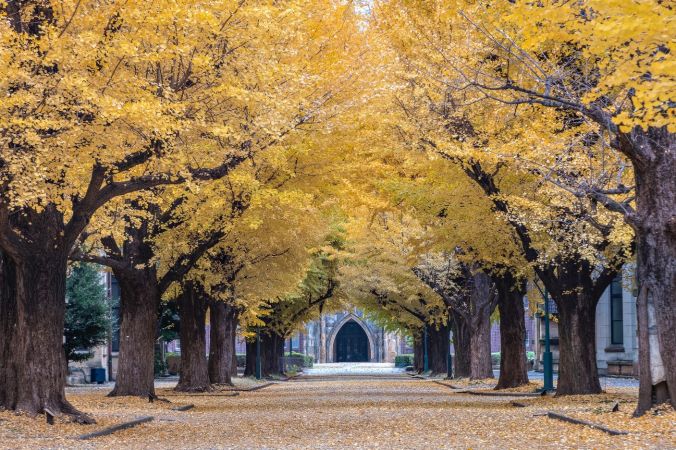
In a country where over 80% of students graduate from high school and join some form of higher education institution — 50% of high schoolers launching directly into university studies — is not so common, the choice to skip higher education is not so common. “I feel that many students feel like university is the only good option to take — or the only options they should take,” says Taku Imai, who joined the Japanese Maritime Self- Defense Force rather than going to university and now owns an IT company in Shinjuku.
2020 saw the highest enrolment numbers Japanese higher education institutions have ever seen, and the pressure on students to attend the most prestigious of these can be understandably intense. Dr. Wataru Hanai works at the National Centre for University Entrance Examination, and explains that entrance exams for these schools are often now seen as responsible for a student’s entire future. “But for those who have failed their university entrance exam, there are still several options,” he reassures, “such as vocational schools/courses, to take the entrance exam again the next year or — for students from families who can afford it — also going to universities abroad.”
Professor Atsuko Kashiwagi, Chairman of the Global Promotion Committee at Showa Women’s University, partly attributes this academic stress to Japanese companies. “The hiring practices of Japanese companies still tend to place more weight on the ‘brand name value’ of the college attended, not on actual academic achievement — and the students know it.” After many years of hard study, students generally feel they deserve a break, and are not so keen to put in the hard work of rigorous academic pursuits.
Do what you want to do, the world is big enough.
Yet for Imai, his choice to not follow higher education was never synonymous with failure or poor preparation for his career. His experience led him to learn a second language, intensely train to learn new skills, work with international communities and travel the world. “The navy taught me so many lessons and opened my eyes in a way a professor never could. I became more of a global citizen. Sometimes I feel like that causes a gap between myself and my IT team, many of whom went to top universities in Japan.”
Seiji Asano, an event organizer from Tokyo who now lives in Berlin, has a different story. “To be blunt,” he admits, “I’ve no idea about what else you could do other than university. I don’t have any friends who did anything other than do an undergraduate course. However, that doesn’t mean it’s the right or the only thing to do, and more and more students and parents are starting to realize that. Do what you want to do, the world is big enough.”
According to Professor Yukiko Ishikura, Associate Professor at the Centre for International Education and Exchange at Osaka University, the concerns of both students and their institutions are indeed changing. “When I was in high school, we used the word ‘examination hell;’ we had to impress the universities. But now, students are the ones who choose their university, not the other way around.”
This is in part due to Japan’s declining population, meaning universities must be less selective in their admissions — especially smaller-scale private institutions. The pressure for the country to globalize has created another problem for universities: they must become more international.
After the success of the nationwide Global 30 Project in attracting unprecedented numbers of overseas students, Kyoto University launched its ambitious project to hire 100 international faculty members. The move would kill three academic headaches with one stone. The number of courses taught in English would increase, its student population would become more diverse and it would pave the way for other institutions with its new International Undergraduate Program (IUP) — something Osaka University also followed suit on.
‘Why do you want to study abroad when you can learn everything you need here?’
“I think Kyoto has been a great success here, because the [IUP] breaks the usual language divide between Japanese and international students and includes the university as a whole,” Professor Ishikura says. “In the third year, international students are able to take courses in Japanese with domestic students. At the same time, domestic students can take English-medium courses, meaning both groups of students can go back and forth between the languages in their modules.”
Even before the COVID-19 pandemic, universities had been seeing a declining interest in their study abroad options. Aside from the financial burden, Professor Kashiwagi suggests this may be because of what is often referred to as an ‘inward-looking’ tendency among Japanese youth. “According to one government study in 2019, only one third of young people in Japan want to study abroad, compared to 66% in South Korea,” she adds.
“One day, I was talking to a group of freshmen over lunch. I was talking based on the assumption that all young people want to go outside Japan to see the world, but they looked puzzled and one of them asked me: ‘Why do you want to study abroad when you can learn everything you need here?’ The students had a totally different attitude.”
I knew I wanted to see and learn more about the world and became a serial expat. Now, I have lived in 14 countries, with two TCKs of my own.
On the other side of the scale are the overseas students coming to Japan. Dr. Helen Maffini is an international education consultant and author who not only actively researches but has experienced life as what’s known as a Third Culture Kid (TCK).
“I moved to Japan when I was 15, from Canada, with my parents. They lived in Shizuoka and my sister and I were boarders at the Canadian Academy in Kobe. I found the academic standards were much, much harder in Japan than my public school in Canada. That was quite a shock. I went from being a ‘A’ student to a ‘B’ or ‘C’ student, and that was quite difficult for me.”
“Moving to Japan opened my mind and changed my whole life,” she continues. “I knew I wanted to see and learn more about the world and became a serial expat. Now, I have lived in 14 countries, with two TCKs of my own.”
Dr. Maffini’s education and career pathway was certainly more international than most, but Japanese universities, students and employers must continue to collectively lean towards the international if they, and their country, are to continue to thrive.
Professor Kashiwagi explains that, as the job market rapidly globalizes, Japan’s youth must increasingly compete with candidates from other countries. “As such, Japanese universities must strive to change the mindset of Japanese companies and society as a whole, so that they will place value on what students actually learn and experience during college, not the name of the college attended.”
“To be honest,” adds Professor Ishikura, “national universities really hate change, but I think we don’t really have any options. We can’t keep providing the same kind of courses, the same quality of courses. That’s not what the students want anymore and it’s not how to internationalize. Right now, students want to be actively engaged with other students or professors — more student-centered learning.”
On the one hand, this student- centered learning, along with more diverse courses and freer selection processes will bless students with an ever-evolving freedom of choice.
But that freedom also comes with an inevitability. They, their institutions and employees must collectively shoulder the responsibility of shifting towards a future that looks beyond the grade of an entrance exam or the ‘brand value’ of a university — out to a more global stage.







